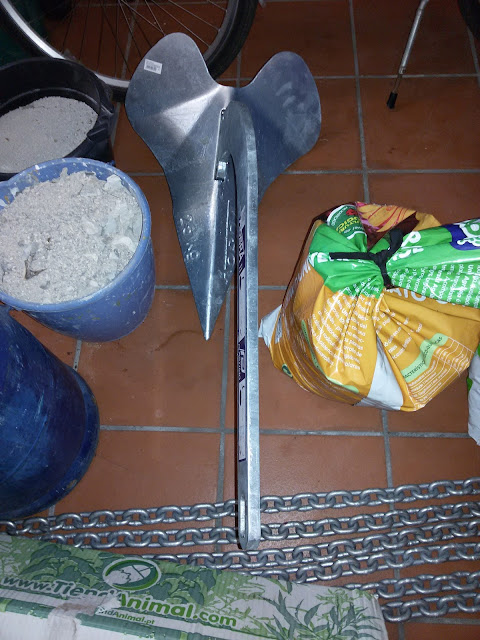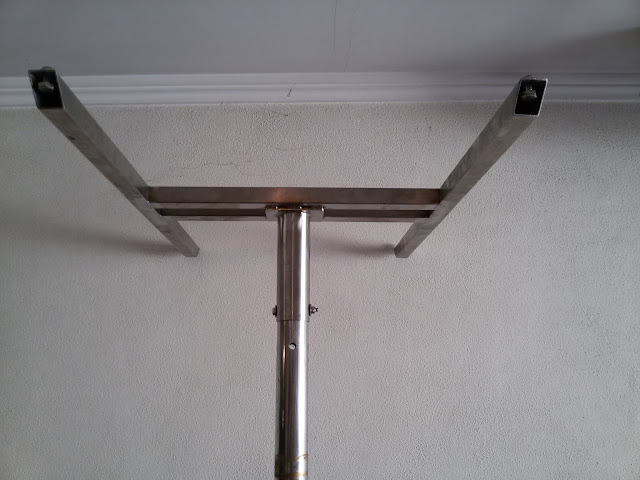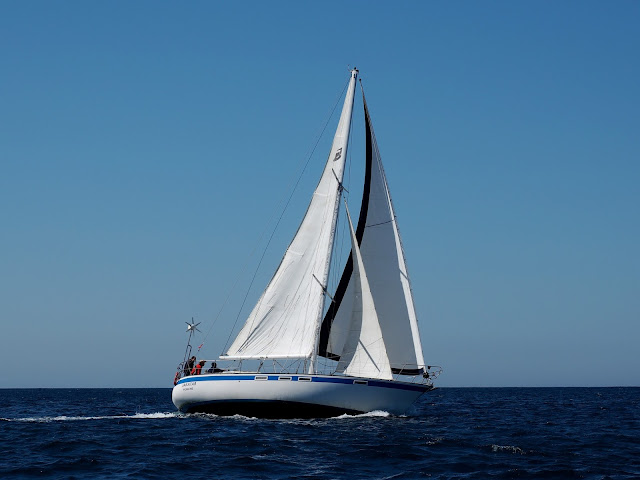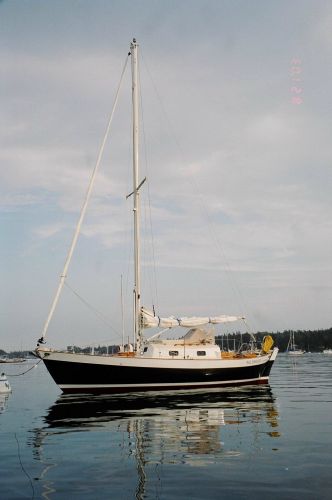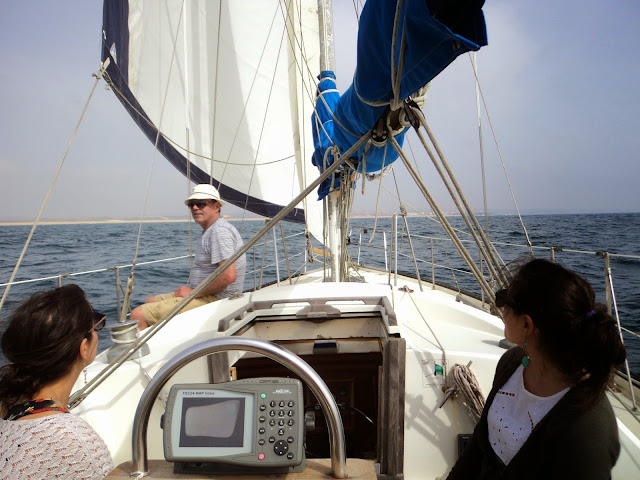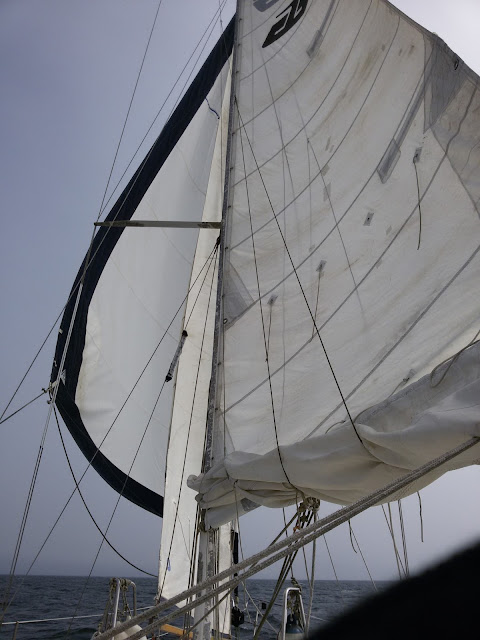 |
| Sailing wing-on-wing without a pole. |
The boat is anchored in Culatra and I'm back home temporarily taking care of some business.
At high tide, Jakatar is swinging on 4:1 scope. My main fear is that a clueless marina skipper - and there's no shortage of them - will anchor too close and pull up my anchor in the process.
Part 1 - Peniche to Cascais (44 miles)
I left Peniche solo on July 26 at 10:30 in the company of a a Bavaria 32 sailed by my friend David, also solo. I left the marina with one concern gnawing at me: my new 25 kg Kobra anchor was/is attached to two pieces of spliced chain totaling 35 m, which is not the ideal situation.* Not forgetting last year's anchor disaster, I do have a spare 45-pound plow anchor on 15 m of 8 mm chain and 40 m of line stowed in the sail locker ready for deployment.
The trip was a mix bag of sailing, motor-sailing and motoring. At the dreaded Cabo Raso (which should be renamed Cape Fear), the wind was only about 25 kt but we hit a wall of fog. Wind and fog don't usually mix, but Cabo Raso is a devilish place where anything can and will happen.
I was quite amused to see a large ketch that had been shadowing me farther offshore disappear into the fog. In a matter of minutes, I saw it motoring back at full steam, after which it spun around facing the enemy, like a bullfighting horse turning on its hind legs to face the bull from a safe distance. I don't blame them. They were obviously going farther south and about to enter a busy shipping lane.
The trip was a mix bag of sailing, motor-sailing and motoring. At the dreaded Cabo Raso (which should be renamed Cape Fear), the wind was only about 25 kt but we hit a wall of fog. Wind and fog don't usually mix, but Cabo Raso is a devilish place where anything can and will happen.
I was quite amused to see a large ketch that had been shadowing me farther offshore disappear into the fog. In a matter of minutes, I saw it motoring back at full steam, after which it spun around facing the enemy, like a bullfighting horse turning on its hind legs to face the bull from a safe distance. I don't blame them. They were obviously going farther south and about to enter a busy shipping lane.
We went ashore for dinner at a local restaurant that is getting more touristy and expensive as the years go by. The sardines were dry and the owner, on recognizing us, insisted on telling us his life story, which you probably don't want to know.
I'll tell you anyway. He claims to have been a barefoot, poverty-stricken kid who left home at 14 years of age, went hungry, worked hard and now works even harder. "Slept only 3 hours last night," he boasted. I think he was merely distracting us in the hope that we wouldn't notice that the sardines were like old leather shoes. Next time maybe I'll eat on the boat and spend the money on drinks at a sleazy bar. I've heard that bored middle-aged women are attracted to the smell of seamen.
I'll tell you anyway. He claims to have been a barefoot, poverty-stricken kid who left home at 14 years of age, went hungry, worked hard and now works even harder. "Slept only 3 hours last night," he boasted. I think he was merely distracting us in the hope that we wouldn't notice that the sardines were like old leather shoes. Next time maybe I'll eat on the boat and spend the money on drinks at a sleazy bar. I've heard that bored middle-aged women are attracted to the smell of seamen.
Speaking of marina skippers and anchoring, going back to the boats we found that David's boat had dragged onto a fisherman's mooring buoy which had a filthy shuttle boat on it. The mother boat must have gone out for the night. The lines were fouled on the Bavaria's rudder and we had to do some cutting and retying, not before David cut the wrong line holding the dinghy connected to the buoy. Sitting on the oily dinghy, I caught it just in time and found myself holding the line that kept the dinghy and David's boat from floating away. Grunting and groaning, I finally managed to tie the nylon line to an oar lock.
Slept like a rock (or is is it "slept like a log"). I always sleep well, but it feels better on an anchored boat that's going somewhere.
Slept like a rock (or is is it "slept like a log"). I always sleep well, but it feels better on an anchored boat that's going somewhere.
* Wrong chain
Take note owners of a SL 555 Sea Tiger windlass looking to buy European chain.
If your windlass has a gypsy with 7 pockets = RCB70 – only 10 mm DIN 766 chain will fit (which means that the chain links are exactly 48 mm in total length.
After losing all my chain last year, I ordered a 15-m test piece which I would use for the spare anchor. It was a perfect fit. The problem was that they gave me the wrong reference number. I used that reference number to buy 60 m of chain and, because of the wrong original reference number, I got the wrong chain.
The shop didn't want to take responsibility until I showed them two bills of sale for chain with the same reference number but different sizes. Seeing as they couldn't get the right size chain quickly, they lent me a 20 m piece they had at the shop, which I joined to the original 15 m test piece. It does the trick for now if I anchor in shallow water.



